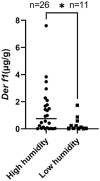Effect of indoor house dust mite concentration on canine atopic dermatitis
- PMID: 36816188
- PMCID: PMC9932715
- DOI: 10.3389/fvets.2023.1078306
Effect of indoor house dust mite concentration on canine atopic dermatitis
Abstract
Introduction: House dust mites (HDM) are regarded as essential environmental allergens not only in human, but also in canine atopic dermatitis (CAD), however, there are only a few studies on the influence of indoor HDM concentration on the disease.
Methods: Our study analyzed the correlation between the indoor HDM concentration, the severity of CAD, and the residential environments in client-owned 35 AD and 13 healthy dogs. We measured the extent of CAD and severity index-04 (CADESI-04), pruritus visual analog scale (PVAS), and transepidermal water loss (TEWL), indoor relative humidity (RH) and analyzed the residential environment questionnaires to evaluate AD severity.
Results: The Der f 1 concentration had an inverse association with TEWL, and no association with CADESI-04 and PVAS. The Der f 1 concentration was significantly high in the group living near the green area and 40% or higher RH.
Discussion: Our results suggest two possibilities: (1) Living around green areas and maintaining an appropriate indoor climate may help to improve CAD clinical symptoms. (2) The HDM may contain endotoxin and when present in high concentrations in CAD, they play a preventive role by enhancing the skin barrier function. Further studies with a larger number of dogs may help further elucidate an association between CAD and Der f 1.
Keywords: atopic dermatitis; dog; environment; house dust mites; transepidermal water loss.
Copyright © 2023 Kim, Lee, Song and Kim.
Conflict of interest statement
The authors declare that the research was conducted in the absence of any commercial or financial relationships that could be construed as a potential conflict of interest.
Figures





Similar articles
-
Indoor endotoxin and house dust mite concentrations in the canine homologue of human atopic dermatitis.One Health. 2025 May 16;20:101076. doi: 10.1016/j.onehlt.2025.101076. eCollection 2025 Jun. One Health. 2025. PMID: 40486749 Free PMC article.
-
Establishing an experimental model for canine atopic dermatitis through epicutaneous application of Dermatophagoides farinae.Front Vet Sci. 2022 Oct 20;9:1015915. doi: 10.3389/fvets.2022.1015915. eCollection 2022. Front Vet Sci. 2022. PMID: 36337184 Free PMC article.
-
Topical treatment with SPHINGOLIPIDS and GLYCOSAMINOGLYCANS for canine atopic dermatitis.BMC Vet Res. 2020 Mar 20;16(1):92. doi: 10.1186/s12917-020-02306-6. BMC Vet Res. 2020. PMID: 32197613 Free PMC article.
-
House dust and forage mite allergens and their role in human and canine atopic dermatitis.Vet Dermatol. 2006 Aug;17(4):223-35. doi: 10.1111/j.1365-3164.2006.00532.x. Vet Dermatol. 2006. PMID: 16827665 Review.
-
Can house dust mite-triggered atopic dermatitis be alleviated using acaricides?Br J Dermatol. 1997 Jul;137(1):1-8. Br J Dermatol. 1997. PMID: 9274618 Review.
Cited by
-
Indoor endotoxin and house dust mite concentrations in the canine homologue of human atopic dermatitis.One Health. 2025 May 16;20:101076. doi: 10.1016/j.onehlt.2025.101076. eCollection 2025 Jun. One Health. 2025. PMID: 40486749 Free PMC article.
-
Trichohyalin gene expression is negatively correlated with the severity of dermatitis in a canine atopic dermatitis model.Front Vet Sci. 2024 Aug 21;11:1396557. doi: 10.3389/fvets.2024.1396557. eCollection 2024. Front Vet Sci. 2024. PMID: 39234173 Free PMC article.
References
LinkOut - more resources
Full Text Sources
Miscellaneous

